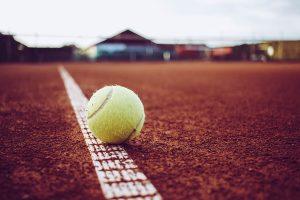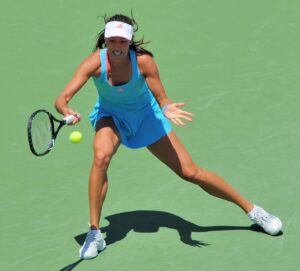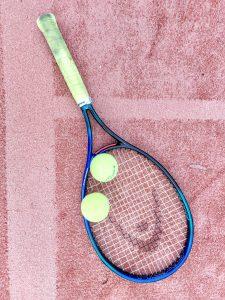We may earn money or products from the companies mentioned in this post.
Introduction to Receiving a Serve in Tennis

Tennis is a game of strategy, skill, and precision One crucial aspect of the game is receiving a serve The way a player positions themselves when receiving a serve can have a significant impact on their ability to react and return the ball effectively
The Importance of Positioning
Positioning is key when it comes to receiving a serve in tennis It sets the foundation for how well a player can respond to their opponent’s shot By positioning themselves correctly, players can optimize their chances of returning the ball with accuracy and power
When receiving a serve, players need to consider both their lateral and depth positioning on the court Being in the right position allows them to cover more ground and reach shots that are hit wide or deep
Impact on Reactivity
A well-positioned player has an advantage in terms of reactivity By being properly aligned with the incoming ball, they can react faster and make split-second decisions about where they want to place their return shot
This quick reaction time gives them more control over their returns, enabling them to direct the ball strategically and potentially catch their opponent off guard
Anticipating Serve Type and Direction
An essential part of receiving a serve is anticipating both its type and direction Experienced players often study their opponents’ serving patterns, looking for cues that indicate what kind of shot is coming next
By carefully observing an opponent’s body language, grip changes, or toss height during the serve motion, skilled receivers can predict whether it will be a flat serve, kick serve, slice serve, or any other variation This anticipation helps them position themselves ideally for returning that particular type of shot
In addition to anticipating the serve type, players also need to read the direction in which the serve is headed This involves analyzing factors such as the server’s shoulder rotation, racket angle, and ball toss placement
By accurately predicting where the ball will land, receivers can adjust their positioning accordingly and be ready to make a well-executed return
In conclusion, receiving a serve in tennis requires proper positioning and anticipation skills Players must position themselves strategically on the court to optimize their reactivity and cover all possible shot angles Anticipating both the serve type and direction adds an extra layer of preparation, enabling them to be more effective in returning their opponents’ shots
Factors affecting where to stand when receiving a serve

When it comes to positioning yourself for a serve, there are several factors that come into play By carefully assessing the server’s skill level and tendencies, as well as considering your own strengths and weaknesses, you can strategically position yourself to gain an advantage on the court
Assessing the server’s skill level and tendencies
The first step in determining where to stand is to assess the server’s skill level and tendencies You want to identify their preferred serving patterns or habits Are they more comfortable serving down the middle or targeting the corners? Do they have a reliable first serve or do they often go for power at the expense of consistency?
By understanding these aspects of their game, you can adjust your position accordingly If they tend to favor one side over the other, you may want to position yourself closer to that side in order to anticipate their serves better Similarly, if they have a strong first serve but struggle with second serves, you may want to adjust your positioning based on their reliability under pressure
Player’s own skill level, strengths, and weaknesses
In addition to assessing the server, it’s important to consider your own skill level, strengths, and weaknesses when deciding where to stand when receiving a serve Finding a comfortable position that maximizes your personal abilities is key
If you have a strong return game and are confident in your ability to return powerful serves with accuracy, you might choose a more aggressive stance closer to the baseline On the other hand, if consistency is your strength and you prefer longer rallies, positioning yourself further back might be more beneficial
Furthermore, adapting your positioning can help minimize vulnerabilities in your game If you struggle with returns on certain sides of the court or have difficulty with high-bouncing serves, adjusting your position can compensate for these weaknesses and give you a better chance at returning the serve effectively
In conclusion, where to stand when receiving a serve depends on a combination of factors including the server’s skill level and tendencies, as well as your own abilities and weaknesses By taking these factors into account and making strategic adjustments in your positioning, you can improve your chances of successfully returning the serve and gaining an advantage in the game
Different starting positions for different types of serves

Handling flat serves
When facing a powerful flat serve, it’s crucial to give yourself enough reaction time to effectively return the ball To achieve this, it is recommended to stand further back from the baseline By positioning yourself deeper in the court, you gain valuable milliseconds to read and react to the serve
To enhance your chances of returning powerful flat serves, employing specific strategies can be beneficial One approach is to focus on early preparation and quick footwork By anticipating the direction and speed of the serve, you can position yourself optimally for a well-executed return
Addressing slice serves
Dealing with slice serves requires adjusting your starting position slightly differently compared to flat serves To counteract the wide angles caused by spin, it is advisable to position yourself closer to the sideline This positioning allows for better coverage of potential wide shots resulting from slice serves
Strategies for handling different directions of slice serves depend on whether they are directed towards your backhand or forehand side For backhand slices, adjusting your grip and using compact swings can help you effectively handle these tricky shots On the other hand, being ready to step into the court and use an open stance can aid in handling forehand slice serves with confidence
Managing kick/topspin serves
Kick or topspin serves pose their own unique challenges due to their high bouncing effect after landing To combat this bounce effectively, it is recommended that players stand closer to the baseline when facing kick or topspin serves
Tactics for countering high-bouncing topspin/kick serves involve taking an assertive approach at impact by stepping forward into the court while maintaining good balance and stability This allows for a more controlled return and minimizes the advantage of the server’s spin
Advanced Techniques and Adjustments When Receiving a Serve in Tennis

Adjustments Based on Court Surface (Type)
In the world of tennis, the court surface can greatly impact gameplay Different surfaces, such as clay courts, grass courts, and hard courts, require unique adjustments when it comes to receiving a serve
-
Clay Courts:
On clay courts, players need to adapt their positioning strategies due to the slower ball speed and higher bounce This means positioning themselves further back from the baseline to give themselves more time to react to the incoming serve -
Grass Courts:
Grass courts provide faster ball speed and lower bounce compared to other surfaces To effectively receive a serve on grass, players should adjust their positioning strategies accordingly Moving slightly closer to the baseline can help them handle the swifter pace of serves -
Hard Courts:
Hard courts offer medium-paced balls with consistent bounce Players should consider positioning themselves at an optimal distance from the baseline based on their comfort level and ability to react quickly
Changing Stance During Points Games/Matches
The stance during points games or matches plays a crucial role in how players receive serves Depending on various factors, players may choose between adopting an aggressive stance or using a defensive stance
-
Aggressive Stance:
When looking to put pressure on the server, players often adopt an aggressive stance by moving forward towards the net This approach allows them to take control of the point early on and potentially disrupt their opponent’s rhythm -
Defensive Stance:
Against powerful servers who possess strong serves, players may opt for a defensive stance by moving slightly back from the baseline This adjustment provides them with better reaction time, allowing them to return powerful serves more effectively
Reading and Anticipating Serves
One of the key skills in receiving a serve is the ability to read and anticipate the opponent’s serve By paying close attention to their body language, ball toss, and racket swing patterns, players can make predictions about the incoming serve and adjust their positioning accordingly
-
Recognizing Body Language:
Players can observe subtle cues in their opponent’s body language that hint at where they might be aiming their serve A slight shift in weight or a certain posture can provide valuable information for positioning adjustments -
Ball Toss and Racket Swing Patterns:
The way an opponent tosses the ball before serving and swings their racket can also offer clues about the type of serve they are likely to hit Observing these patterns allows players to anticipate better and position themselves optimally on the court
In conclusion, advanced techniques and adjustments when receiving a serve in tennis involve adapting strategies based on court surface type, changing stances during points games/matches, and reading and anticipating serves through careful observation Incorporating these techniques into gameplay can enhance a player’s ability to handle varying serves effectively, giving them an advantage on the court
Useful Links

Rules of the Tennis Serve: An Exhaustive Guide
Rules of Tennis | Wanless Park Tennis
The Tennis Serve Stance Guide: Platform & Pinpoint
Tennis Serving Rules 101
Where Do You Stand To Receive A Serve In Padel? – Padeld
What to Do When Your Opponent Is Moving During …
Where can you stand receiving in doubles
5 Tips for Returning Serve
How to Serve in Tennis: 6-Step Guide
How to Serve a Tennis Ball (with Pictures)
Tennis: When playing doubles, is it not allowed for both …
How To Return A Fast Tennis Serve
PEIN (v.2.1) – Tennis Flashcards
TENNIS RULES
Return of serve technique in tennis
Why The Jump Serve Is Illegal In Tennis
Tennis Study Guide






